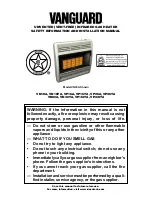
23
INSTALLATION
THIS WATER HEATER IS NOT SUITABLE FOR POOL HEATING
INSTALLATION STANDARDS
The water heater must be installed:
by a qualified person, and
in accordance with the installation instructions, and
in compliance with Standards AS/NZS 3500.4, AS/NZS 3000 and all local codes and regulatory authority
requirements.
All packaging materials must be removed from the water heater prior to its installation. This includes the
removal of the cardboard base of the carton from the underside of the water heater.
WATER HEATER APPLICATION
This water heater is designed for use in a single family domestic dwelling for the purpose of heating potable
water. Its use in an application other than this may shorten its life.
If this water heater is to be used where an uninterrupted hot water supply is necessary for the application or
business, then there should be back-up redundancy within the hot water system design. This should ensure
the continuity of hot water supply in the event that this water heater was to become inoperable for any reason.
We recommend you provide advice to the system owner about their needs and building back-up redundancy
into the hot water supply system.
Notes
If the water heater tank is installed without either the external control device or connection to a home
energy management system (HEMS), then it will operate as a conventional twin element electric water
heater only. It will not be able to take advantage of excess solar PV power production or be part of an
intelligent water heating system.
If the water heater is installed on a property that has export limiting capability of the solar PV power
production, then it must be connected to a home energy management system (HEMS) for it to operate
using excess solar PV power production.
WATER HEATER LOCATION
The water heater is suitable for either indoor or outdoor installation.
Whether located outdoor or indoor, the water heater should be
installed close to the most frequently used outlet and its position
chosen with safety and service in mind.
Clearance must be allowed for servicing of the water heater. The
water heater must be accessible without the use of a ladder or
scaffold. Make sure the temperature pressure relief valve lever is
accessible and the front cover, thermostat, heating unit can be
removed for service.
You must be able to read the information on the rating plate. If
possible leave headroom of one water heater height so the anode can
be inspected or replaced. Remember you may have to take the entire
water heater out later for servicing. Remember all local authorities
have regulations about putting water heaters into roof spaces.
The water heater is to be installed at ground or floor level and must stand vertically upright on a stable base
as acceptable to local authorities. The base of the water heater is made of corrosion resistant material, and it
may be placed directly in contact with the supporting surface. It is not necessary to allow for free air circulation
under the base of the water heater.
Note:
The water heater should not be placed in direct contact with a concrete surface that is less than two
months old and not fully cured as this may attack the metal coating of the water heater base. A moisture barrier
should be used between the two surfaces in this instance.














































